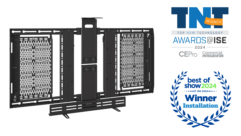

IT network managers often indicate that video should be on its own VLAN. Some AV vendors say that the traffic created by their devices should be on a single subnet. In most situations both are looking for a route that will segregate their traffic from other potentially interfering flows. The purpose of this newsletter is to investigate these two concepts- the VLAN and the subnet.
First, A VLAN is different from a subnet. While they are often confused and even sometimes serve the same role in deployments, they are not identical. VLANS are based on mac addresses i.e. hardware addresses. The device’s mac addresses are assigned in the factory during manufacturing and are almost never changed. Subnets are based on IP addresses. These are generally assigned automatically by DHCP servers or assigned manually using software within the device. A VLAN is defined by a group of mac addresses. A subnet is defined by a group of IP addresses. Two subnets could exist on a single physical Ethernet network. Traffic between the two subnets would be routed based on the IP address assignments. Traffic between two VLANS could be routed but the flow would be determined by the mac addresses or ports on the switch to which they are connected. It’s best to think of VLANS as individual physical networks that need to be connected by a device capable of routing traffic.
So, how is each of these used in AV deployments? When you place cameras in a separate VLAN, you isolate their video traffic from any outside traffic. This can be very good if the other traffic in the network is bursty or frequently uses high levels of bandwidth. However, it also means that critical services such as DHCP must also be available within the VLAN. By contrast, using a subnet to separate devices is often done for organizational purposes. For example, in a university, the schools might be assigned to separate subnets. Then, within a school, separate VLANS could be used to separate voice, data and video. (See the Table).
One other factor is often important to AV devices. They frequently have the ability to auto-discover each other. There are two ways this can be accomplished. The first is to use broadcast discovery packets with containing codes that say, “If you are a Brand X device, respond to this query.” The second is to use the ARP (address resolution protocol). ARP allows a device to announce its presence and to ask another device for that device’s IP address. Both techniques are based on broadcast packets. These packets cannot cross either VLAN or subnet boundaries. So, if your camera cannot automatically discover its recorder, check to make sure they are on the same VLAN or subnet.










